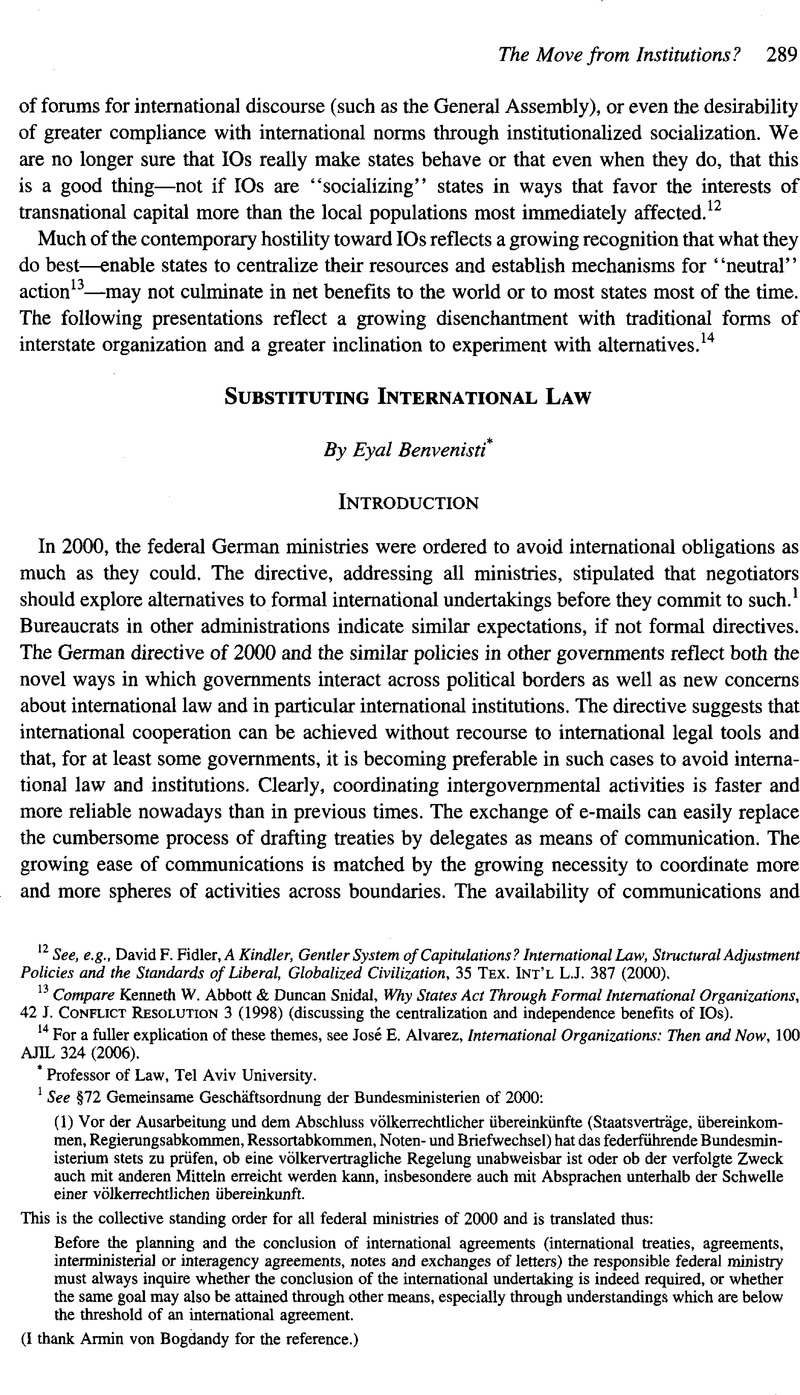Published online by Cambridge University Press: 28 February 2017

1 See §72 Gemeinsame Geschäftsordnung der Bundesministerien of 2000:
(1) Vor der Ausarbeitung und dem Abschluss völkerrechtlicher Übereinkünfte (Staatsverträge, übereinkommen, Regierungsabkommen, Ressortabkommen, Noten- und Briefwechsel) hat das federführende Bundesministerium stets zu prüfen, ob eine völkervertragliche Regelung unabweisbar ist oder ob der verfolgte Zweck auch mit anderen Mitteln erreicht werden kann, insbesondere auch mit Absprachen unterhalb der Schwelle einer völkerrechtlichen Übereinkunft.
This is the collective standing order for all federal ministries of 2000 and is translated thus:
Before the planning and the conclusion of international agreements (international treaties, agreements, interministerial or interagency agreements, notes and exchanges of letters) the responsible federal ministry must always inquire whether the conclusion of the international undertaking is indeed required, or whether the same goal may also be attained through other means, especially through understandings which are below the threshold of an international agreement.
(I thank Armin von Bogdandy for the reference.)
2 Anne-Marie Slaughter, A New World Order (2004).
3 At <http://www.zanggercommittee.org/Zangger/default.htm>. The Zangger Committee, out of the closet since 1990, is still active and consists of 35 members who are capable of supplying nuclear items under regulation. On this committee, see Schmidt, Fritz, NPT Export Controls and the Zangger Committee, Nonproliferation Rev. 136 (Fall-Winter 2000), available at <http://www.zanggercommittee.org/Nr/rdonlyres/4Bf85482-C595-4Af7-99Fa-609684913B5E/8806/Monterey2000.pdf>CrossRefGoogle Scholar.
4 See Schmidt, supra note 3, at 138.
5 See the Australia Group’s Web site, available at <http://www.austraHagroup.net/>.
6 On the MTCR, see <http://www.mtcr.info/english/index.html>. On the Wassenaar Arrangement, see <http://www.wassenaar.org/> (particularly its “Guidelines and Procedures”) at <http://www.wassenaar.org/guidelines/guidelines.doc)>. For an analysis of the effective enforcement of the MTCR policies by the United States for China, see Angelova, Anastasia A. Compelling Compliance with International Regimes: China and the Missile Technology Control Regime, 38 Colum. J. Transnat’l L. 419 (1999)Google Scholar.
7 See Busuttil, James J. The Bonn Declaration on International Terrorism: A Non-Binding International Agreement on Aircraft Hijacking, 31 Int’l & Comp. L. Q. 474 (1982)CrossRefGoogle Scholar.
8 On the FATF, see its official Web site, available at <http://www.fatf-gafi.org/pages/0,2987,en_32250379_32235720_l_l_l_l_l,00.html>.
9 On the PSI, see <http://www.state.gov/t/np/cl0390.htm>. See also Becker, Michael A. The Shifting Public Order of the Oceans: Freedom of Navigation and the Interdiction of Ships at Sea, 46 Harv. Int’l L. J. 131 (2005)Google Scholar.
10 For more discussion of these and other institutions and their impact, see Benvenisti, Eyal, “Coalitions of the Willing” and the Evolution of Informal International Law, in “Coalitions of the Willing”—Avantgarde Or Threat? (Calliess, C., Nolte, G. & Stall, P.-T., eds., forthcoming 2006)Google Scholar.
11 Available at <http://www.theglobalfund.org/en/>.
12 See International Organization for Standardization (ISO): Introduction, available at <http://www.iso.org/iso/en/aboutiso/-introduction/index.html>. The ISO promulgates rules that are firmly rooted in industry practice and market experience. On the ISO, see Levit, Janet Koven, A Bottom-Up Approach to International Lawmaking: The Tale of Three Trade Finance Instruments 30 Yale J. Int’l L. 125 (2005)Google Scholar.
13 See the IASB website at <http://www.iasb.org/>. The IASB was preceded by the weaker board of the International Accounting Standards Committee (IASC), which operated from 1973 until 2001. On the IASB, see Mattli, Walter & Biithe, Tim, Global Private Governance: Lessons from a National Model of Setting Standards in Accounting, 68 Law & Contemp. Probs. 225 (2005)Google Scholar.
14 Available at <http://www.fairlabor.org/all/about/index.html>. See Workplace Code of Conduct and Principles of Monitoring, Fair Labor Ass’n, at <http://www.fairlabor.org/html/CodeofConduct> (providing a “set of standards defining decent and humane working conditions.”).
15 Levit, supra note 12, at 137-39.
16 Id., at 147 er seq.
17 On these concerns, see Slaughter, supra note 2, at 219. On the role of narrow interests in shaping international law and institutions, see Benvenisti, Eyal, Exit and Voice in the Age of Globalization, 98 Mich. L. Rev. 167 (1999)CrossRefGoogle Scholar.